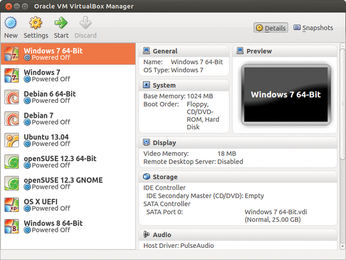Simple DirectMedia Layer 2.0
Since 1998, Simple DirectMedia Layer (SDL) has formed the basis for countless games, multimedia applications, and even virtualization. The small cross-platform library makes it easy for applications to access the graphics card, the audio hardware, the keyboard, and other input devices. Because it is available for many different platforms and operating systems, you can easily port any programs that have been developed with it (see the "Supported Operating Systems" box). Without SDL, Linux users would probably still be waiting for conversions of blockbuster games like Portal (Figures 1 and 2).
 Figure 1: Almost all games offered via Steam, including blockbusters like the puzzle game Portal, are based on SDL.
Figure 1: Almost all games offered via Steam, including blockbusters like the puzzle game Portal, are based on SDL.
 Figure 2: Even serious applications, such as the virtualization software Qemu and VirtualBox, use SDL for their screen output.
Figure 2: Even serious applications, such as the virtualization software Qemu and VirtualBox, use SDL for their screen output.
[...]
Buy this article as PDF
(incl. VAT)
Buy Linux Magazine
Subscribe to our Linux Newsletters
Find Linux and Open Source Jobs
Subscribe to our ADMIN Newsletters
Support Our Work
Linux Magazine content is made possible with support from readers like you. Please consider contributing when you’ve found an article to be beneficial.

News
-
Parrot OS Switches to KDE Plasma Desktop
Yet another distro is making the move to the KDE Plasma desktop.
-
TUXEDO Announces Gemini 17
TUXEDO Computers has released the fourth generation of its Gemini laptop with plenty of updates.
-
Two New Distros Adopt Enlightenment
MX Moksha and AV Linux 25 join ranks with Bodhi Linux and embrace the Enlightenment desktop.
-
Solus Linux 4.8 Removes Python 2
Solus Linux 4.8 has been released with the latest Linux kernel, updated desktops, and a key removal.
-
Zorin OS 18 Hits over a Million Downloads
If you doubt Linux isn't gaining popularity, you only have to look at Zorin OS's download numbers.
-
TUXEDO Computers Scraps Snapdragon X1E-Based Laptop
Due to issues with a Snapdragon CPU, TUXEDO Computers has cancelled its plans to release a laptop based on this elite hardware.
-
Debian Unleashes Debian Libre Live
Debian Libre Live keeps your machine free of proprietary software.
-
Valve Announces Pending Release of Steam Machine
Shout it to the heavens: Steam Machine, powered by Linux, is set to arrive in 2026.
-
Happy Birthday, ADMIN Magazine!
ADMIN is celebrating its 15th anniversary with issue #90.
-
Another Linux Malware Discovered
Russian hackers use Hyper-V to hide malware within Linux virtual machines.

